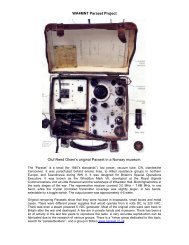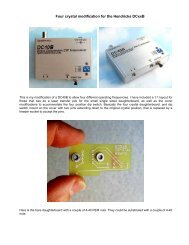Small Magnetic Loop Antenna Project - QRPBuilder.com
Small Magnetic Loop Antenna Project - QRPBuilder.com
Small Magnetic Loop Antenna Project - QRPBuilder.com
You also want an ePaper? Increase the reach of your titles
YUMPU automatically turns print PDFs into web optimized ePapers that Google loves.
Unfortunately such a tower height is impractical in most residential zoning rule situations<br />
imposed by municipal councils and town planners. If the Yagi beam is deployed at a lower<br />
10m height then a diminutive loop will nearly always outperform the beam antenna. This<br />
writer never fails to be amused by folks who acquire a potentially high performance Yagi<br />
HF beam and sacrilegiously deploy it in suboptimal installations in respect of height above<br />
ground or proximity to a metal roof. The problem worsens on the lower bands below 20m<br />
where the resultant high angle lobe pattern direction is not at all very conducive to<br />
facilitating good DX <strong>com</strong>munication.<br />
In <strong>com</strong>parison to a vertically mounted / oriented loop, the bottom of the loop does not need<br />
to more than a loop diameter above ground making it very easy to site in a restricted space<br />
location. There is no significant improvement in performance when a small loop is raised<br />
to great heights; all that matters is the loop is substantially clear of objects in the immediate<br />
surrounds and the desired direction of radiation! Mounting the loop on a short mast above<br />
an elevated roof ground-plane yields excellent results.<br />
A good HF antenna for long haul DX requires launching the majority of the Tx power at a<br />
low angle of radiation; things a good, efficient and properly installed vertical, a properly<br />
sited small magnetic loop, and a big multi-element beam atop a very tall tower do very<br />
well.<br />
Receiving properties:<br />
In a typical high noise urban environment a loop will nearly always hear more than a big<br />
beam on the HF bands. The small magnetic loop antenna (a balanced one) responds<br />
predominately to the magnetic <strong>com</strong>ponent of the incident EM wave, while being nearly<br />
insensitive to the electric field <strong>com</strong>ponent; which is the basic reason why loops are so<br />
impressively quiet on receive; often times dramatically so. They will pull in the weak<br />
signals out of the ambient noise and you will very likely receive stations that you’d never<br />
hear when switching across to a vertical, dipole or beam antenna.<br />
In a propagating radio wave the magnitude of the electric vector is 120π or 26 dB greater<br />
than the magnitude of the magnetic vector, the difference being due to the intrinsic<br />
impedance of free space (377 Ohms). On the other hand the induction fields associated<br />
with man-made noise have electric E-field <strong>com</strong>ponents many times greater than a normal<br />
radiation field (radio wave). While a dipole or vertical antenna is sensitive to both the<br />
electric and magnetic <strong>com</strong>ponents of a wave, the small loop is responsive only to the<br />
magnetic H-field <strong>com</strong>ponent and it will be substantially “blind” and offer a high degree of<br />
rejection to pickup of undesired man made noise and atmospheric disturbances.<br />
Hence the widely used term “magnetic loop” antenna to signify this field discrimination to<br />
the <strong>com</strong>ponents of the in<strong>com</strong>ing incident EM wave. <strong>Antenna</strong> theory treats the loop as the<br />
electrical conjugate of the dipole, i.e. the loop is a “magnetic dipole” while an ordinary<br />
dipole is an “electric dipole”.<br />
Significantly, a small loop antenna will typically produce a signal-to-noise ratio / SNR that<br />
is some 10 to 20 dB greater than a horizontal dipole in a noisy urban environment and an<br />
even greater improvement in SNR when <strong>com</strong>pared to a vertical antenna as a result of the<br />
man-made noise <strong>com</strong>prising a strong electric field <strong>com</strong>ponent and being largely vertically<br />
polarised.<br />
5





